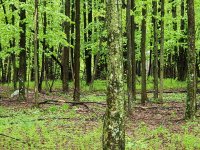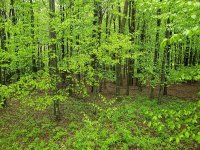buckeyefarmer
Epic Contributor
Depends on how much you thin. If real thick, you need to thin down. If too much is cut, then brush grows up.
Hmmm - buckeyefarmer - that's sure not the way it works in the pine forests around here. You thin and what remains grows big and strong. Otherwise, you end up with stands of spaghetti with green tops.
I wish I could get brush to grow here. I've got eighty acres of one thing or the other - either bunch grass or Ponderosa pine. I thin a stand and both the bunch grass and the remaining pines grow big and strong. I have absolutely no other type of tree on my acreage - just Ponderosa pine. That is the predominant tree in this entire area of NE WA.
We could use some idea of your budget.I'm taking delivery of a Kioti CK3510se TLB next week, along with a 55" Wicked Root Grapple, Piranha Bar, and a Wallenstein Chipper/Shredder. One of the projects on my to-do list is to thin out the forest surrounding my family's place. Total forest area of about 3-4 acres, maybe up to 6-7 depending on how industrious I get. Basically want to get rid of a lot of the young growth (2-3" trees), etc..., but not trying to clear everything. Trying to figure out the best way to go about it. No big rush... will work on this over the summer when I can. I also have a Stihl MS290 chainsaw, and an FS90 string trimmer.<snip>
Yep. Those "spaghetti" trees are already doomed; they have been out-competed by other trees, or by each other in some cases.
We could use some idea of your budget.
Your string trimmer with blade is the tool you need to get small stumps near ground level but I think your FS90 may be underpowered. I've a Stihl FS110 and and FS250 I can handle 2 inch trees easily with the FS250.
...
Since you have a Stihl fs90 already, have you considered a pole saw attachment for it?{about $200.} I have one on my fs110, and it is probably one of my most frequently used tools. ...
There is a dichotomy with forest preservation ideals...one bent is for timber the other for wildlife...
The latter is the reason in many places the USFS "clearcuts" ...undergrowth provides cover for smaller species and the food chain starts at the very tiny but links all the way to the top...
Can your tractor fit in where you want to trim? If so, why not put a bush hog on the back and back over your 1-2" little trees.
Aaron Z


That's one big difference between where you are, and what I'm used to. Here we want to see some undergrowth as that's the next generation of trees. Mature growth is stagnant growth; it's what caribou and a few other species like, but there really isn't much life in declining trees. The American Indians used to burn the hardwood forests of Appalachia occasionally to promote squirrel habitat long before we Europeans et.al. came over... of course back then the hardwood leaves in the forest were a couple of feet deep because there were no earthworms around until they hitchhiked over on our ships.buckeyefarmer - my dad bought this 80 acres in 1939 and took the first pictures of the place in 1940. The only things that have changed in the 80 intervening years - the Ponderosa pines have gotten bigger and since nobody did any thinning - there were lots of thick little pine stands when we came down in '82. The bunch grass and buck brush are exactly the same. And here and there are a sage bush or two.
This semi-arid environment simply does not support thick undergrowth - actually it doesn't support any undergrowth. I can very easily see all the way down the center of my property - 2640 feet - from the East property line to the West property line.
I was looking at those ferns. Whatever you do, try not to disturb the ground too much. One thing that I remember from working in NY is how they like to take over, and the only thing which will grow up through them- eventually- is black cherry.See Post #1, Paragraph 3.
View attachment 555031View attachment 555032
Here's a couple of photos of what I'm dealing with. When I was a kid (40 years ago), some of this was just wild fields with a lot of blueberry bushes. We had a brush fire that cleared a lot of that, and after, larger trees (mostly maples, but some birch and maybe oak?) started growing in. It's not so much 'too thick to walk through', but there are a lot of trees where there are multiple trees growing out of the same stump, or very close together (you can see a bit of that in the photos). I don't know why, but that seems to happen often on our property.
The ferns are starting to grow in already, so some areas might wait until the fall or next spring, but I want to start cleaning up the dead fall.
See Post #1, Paragraph 3.
View attachment 555031View attachment 555032
Here's a couple of photos of what I'm dealing with. When I was a kid (40 years ago), some of this was just wild fields with a lot of blueberry bushes. We had a brush fire that cleared a lot of that, and after, larger trees (mostly maples, but some birch and maybe oak?) started growing in. It's not so much 'too thick to walk through', but there are a lot of trees where there are multiple trees growing out of the same stump, or very close together (you can see a bit of that in the photos). I don't know why, but that seems to happen often on our property.
The ferns are starting to grow in already, so some areas might wait until the fall or next spring, but I want to start cleaning up the dead fall.
I find winter the best time to clear, when you can see what you're dealing with. Seeing your pics, I'd take smaller trees out with a grapple, assuming they didnt sprout from an old stump. I love clearing land, fun seat time.See Post #1, Paragraph 3.
View attachment 555031View attachment 555032
Here's a couple of photos of what I'm dealing with. When I was a kid (40 years ago), some of this was just wild fields with a lot of blueberry bushes. We had a brush fire that cleared a lot of that, and after, larger trees (mostly maples, but some birch and maybe oak?) started growing in. It's not so much 'too thick to walk through', but there are a lot of trees where there are multiple trees growing out of the same stump, or very close together (you can see a bit of that in the photos). I don't know why, but that seems to happen often on our property.
The ferns are starting to grow in already, so some areas might wait until the fall or next spring, but I want to start cleaning up the dead fall.